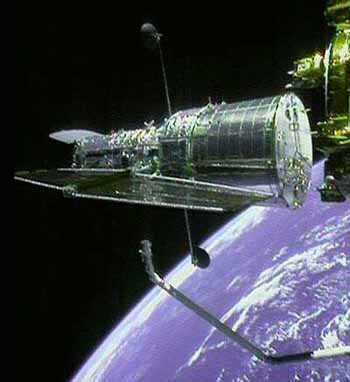Seeing the Universe
1990 - The Hubble Space Telescope
The Hubble Space Telescope, was placed in low Earth orbit from a Space Shuttle in 1990. In its first decade of operation, the HST sent back clearer and further views of the universe than ever before obtained. Its position above the distorting and filtering effects of the atmosphere more than compensates for its relatively small mirror - only 2.5 metres in diameter, much smaller than the largest ground based scopes. Its high resolution camera recorded detail on the surface of Pluto. It peered for one hundred hours into each of two pin-head sized regions of the sky to obtain deep fields that establish the universe contains more than 50 billion galaxies. Its infrared camera pierced deep inside thick dust clouds to heart of stellar nurseries, and resolved newly forming solar systems.
The HST was designed to be upgraded. Space Shuttle Astronauts in three service missions have
already replaced its cameras, solar panels, gyroscopes, computers and data recorders
with improved versions. The image shows the telescope being released back into orbit from
the Shuttle after one of those missions.
![]() STScI: About the HST
STScI: About the HST

HST being released back into orbit from the Space Shuttle
after the third servicing mission, December 1999 (NASA)